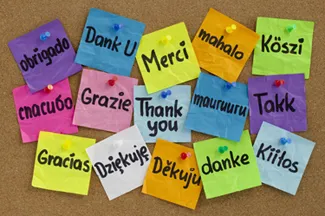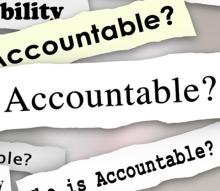
 It’s the week of Thanksgiving. In the United States, this signifies a time of the year when many of us gather around a large meal with family and friends to not only celebrate, but also to reflect on things in our lives for which we are thankful.
Even if you don’t celebrate Thanksgiving, this holiday can be a good reminder to stop and take a moment to be thankful. Studies have shown that cultivating gratitude is beneficial in numerous ways. Being grateful can help crowd out negative emotions, help foster a more positive mental attitude, and positivity has been shown to have huge physical and mental health benefits.
Not only can gratitude increase your sense of well-being, it can also play an important role in your professional trajectory. To clarify, we aren’t talking about the standard thank you letters that you send out after interviews or networking events, even though those are great and extremely important to continue sending. Rather, think about sincerely thanking somebody, which requires taking a moment to pause and acknowledge another's assistance or even just to remark on the great work they are doing. Thank you notes not only make the recipient feel good, but it’s also a beneficial exercise for the letter writer.
As noted in the article “How thank-you notes can transform your career,” gratitude can be professionally powerful. Take the article’s example of Douglas Conant, the former CEO of Campbell Soup. During his ten years at Campbell, he helped turn the company around – he cut costs and implemented innovative marketing efforts all while improving employees’ engagement levels. How did Conant do all of this? Well, for the latter part, he wrote 30,000 thank you notes. He would take about an hour a day to write 10-20 thank you notes to employees at all levels of the company. He had a staffer help him find success stories to praise. Conant is quoted saying, “We’re trained to find things that are wrong, but I try to celebrate what is right.” His focus on strengths worked to help motivate employees and turn a lagging company around.
Mark Zuckerberg, Facebooks’ CEO, took on a gratitude challenge in 2014. Zuckerberg celebrated Facebook’s 10th anniversary year by writing one thank you note each day. His reasoning was similar to Conant’s and he said, “It’s important for me, because I’m a really critical person. I always kind of see how I want things to be better, and I’m generally not happy with how things are, or the level of service that we’re providing for people, or the quality of the teams that we built.”
It can be easy to focus on the negative and dwell on what isn’t going right. In order to cultivate gratitude, we recommend an activity which was previously discussed in a blog post about enhancing optimism and resilience. During Thanksgiving, try this out:
Gratitude Visit and Letter
Close your eyes for a moment and think about a person who helped you out in the past. Perhaps someone you never properly thanked? This is a great activity to help you feel more positive because when you feel grateful, you conjure up a pleasant memory or association. Then, expressing that gratitude can help strengthen your relationship and can create more positive connections. So, give that person a call, write them an e-mail or even drop by their office or home to say thank you!
If you try this activity out, comment and let us know. Thank you, dear readers, for continuing to follow and contribute to this blog!
It’s the week of Thanksgiving. In the United States, this signifies a time of the year when many of us gather around a large meal with family and friends to not only celebrate, but also to reflect on things in our lives for which we are thankful.
Even if you don’t celebrate Thanksgiving, this holiday can be a good reminder to stop and take a moment to be thankful. Studies have shown that cultivating gratitude is beneficial in numerous ways. Being grateful can help crowd out negative emotions, help foster a more positive mental attitude, and positivity has been shown to have huge physical and mental health benefits.
Not only can gratitude increase your sense of well-being, it can also play an important role in your professional trajectory. To clarify, we aren’t talking about the standard thank you letters that you send out after interviews or networking events, even though those are great and extremely important to continue sending. Rather, think about sincerely thanking somebody, which requires taking a moment to pause and acknowledge another's assistance or even just to remark on the great work they are doing. Thank you notes not only make the recipient feel good, but it’s also a beneficial exercise for the letter writer.
As noted in the article “How thank-you notes can transform your career,” gratitude can be professionally powerful. Take the article’s example of Douglas Conant, the former CEO of Campbell Soup. During his ten years at Campbell, he helped turn the company around – he cut costs and implemented innovative marketing efforts all while improving employees’ engagement levels. How did Conant do all of this? Well, for the latter part, he wrote 30,000 thank you notes. He would take about an hour a day to write 10-20 thank you notes to employees at all levels of the company. He had a staffer help him find success stories to praise. Conant is quoted saying, “We’re trained to find things that are wrong, but I try to celebrate what is right.” His focus on strengths worked to help motivate employees and turn a lagging company around.
Mark Zuckerberg, Facebooks’ CEO, took on a gratitude challenge in 2014. Zuckerberg celebrated Facebook’s 10th anniversary year by writing one thank you note each day. His reasoning was similar to Conant’s and he said, “It’s important for me, because I’m a really critical person. I always kind of see how I want things to be better, and I’m generally not happy with how things are, or the level of service that we’re providing for people, or the quality of the teams that we built.”
It can be easy to focus on the negative and dwell on what isn’t going right. In order to cultivate gratitude, we recommend an activity which was previously discussed in a blog post about enhancing optimism and resilience. During Thanksgiving, try this out:
Gratitude Visit and Letter
Close your eyes for a moment and think about a person who helped you out in the past. Perhaps someone you never properly thanked? This is a great activity to help you feel more positive because when you feel grateful, you conjure up a pleasant memory or association. Then, expressing that gratitude can help strengthen your relationship and can create more positive connections. So, give that person a call, write them an e-mail or even drop by their office or home to say thank you!
If you try this activity out, comment and let us know. Thank you, dear readers, for continuing to follow and contribute to this blog!Categories
Blog




